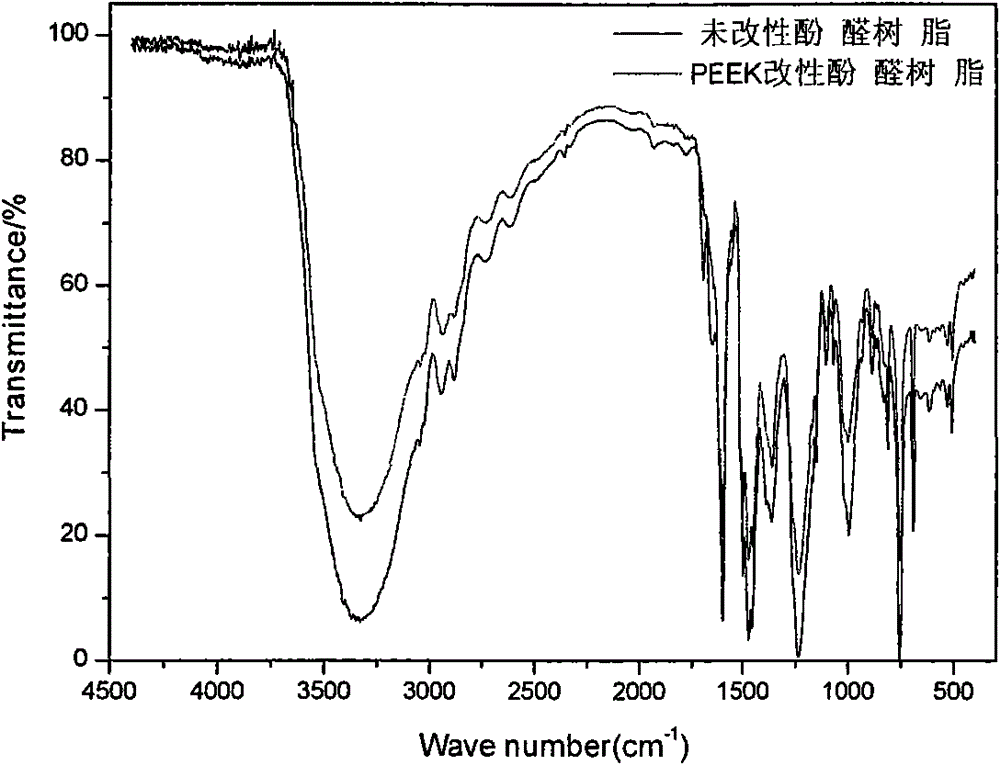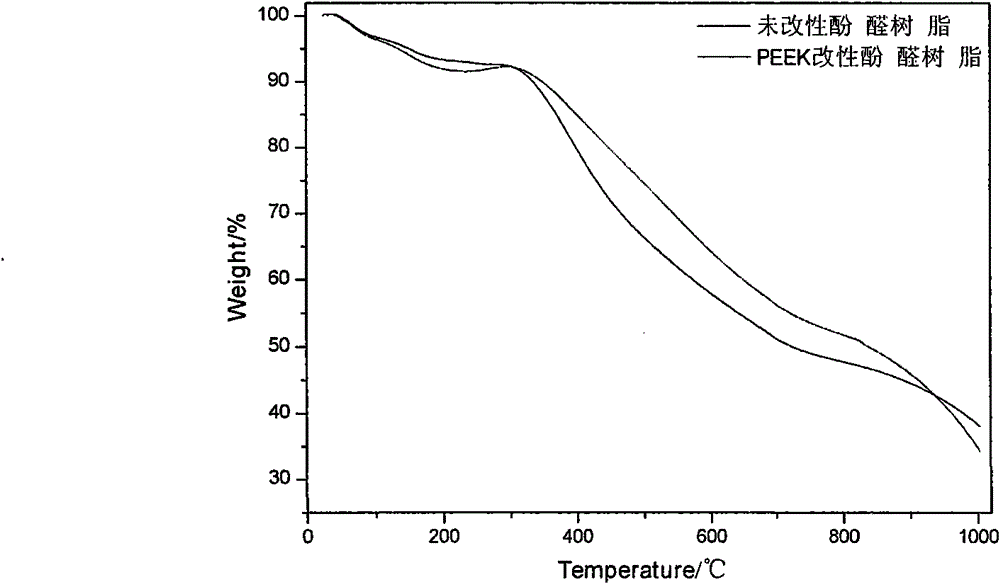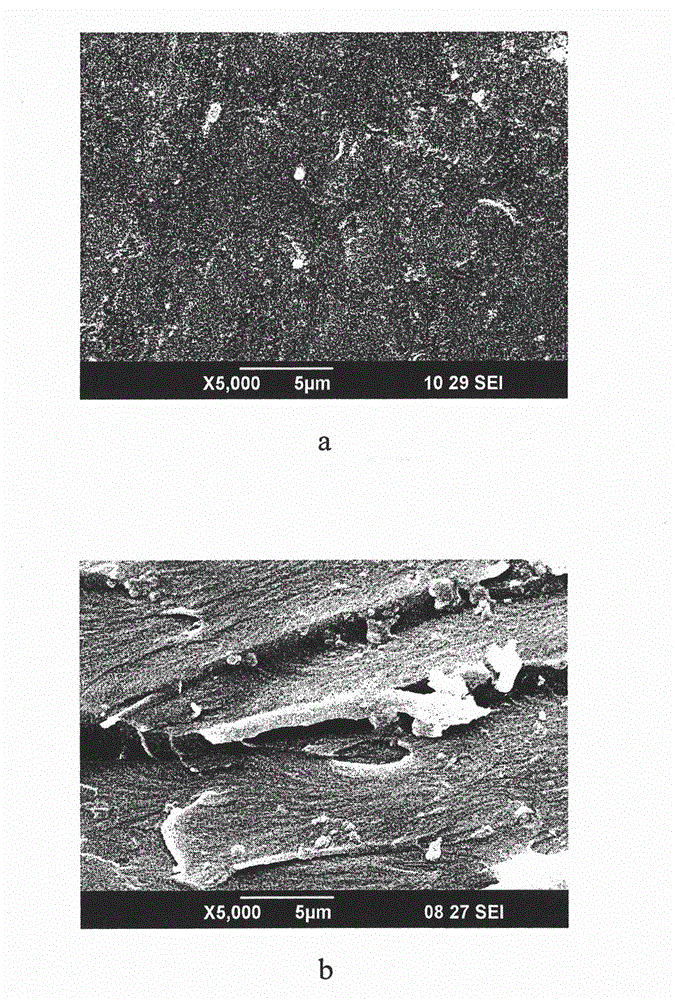PEEK-modified phenol formaldehyde resin and preparation method thereof
A polyether ether ketone and phenolic resin technology, applied in the field of phenolic resin and its preparation, can solve problems such as good solvent resistance, and achieve the effects of improving toughness, improving heat resistance, improving heat resistance and fracture toughness
- Summary
- Abstract
- Description
- Claims
- Application Information
AI Technical Summary
Problems solved by technology
Method used
Image
Examples
Embodiment 1
[0029] Step 1: Add the dried polyether ether ketone into the flask containing the sulfonating agent, under N 2 Stir quickly under protection, react at room temperature for 24 hours, and let it settle;
[0030] Step 2: vacuum filter the sediment, repeatedly wash the sulfonated polyetheretherketone with deionized water until the filtrate is neutral, and dry in vacuum; the sulfonating agent is concentrated sulfuric acid;
[0031] Step 3: Add the dried sulfonated polyether ether ketone into the flask containing the chloromethylation reagent, stir rapidly and raise the temperature to 60°C for 6 hours, and let it settle; the chloromethylation reagent is chloromethyl ether ;
[0032] Step 4: vacuum filter the sediment, repeatedly wash the sulfonated chloromethylated polyetheretherketone with deionized water until the filtrate is neutral, and dry it in vacuum;
[0033] Step 5: In a reactor equipped with a reflux condenser, add 100 parts of phenol under stirring conditions and heat a...
Embodiment 2
[0038] Step 1: Add the dried polyether ether ketone into the flask containing the sulfonating agent, under N 2 Stir rapidly under protection, react at room temperature for 24 hours, let stand and settle; the sulfonating agent is chlorosulfonic acid;
[0039] Step 2: Vacuum filter the precipitate, repeatedly wash the sulfonated polyetheretherketone with deionized water until the filtrate is neutral, and dry it in vacuum;
[0040] Step 3: Add the dried sulfonated polyether ether ketone into the flask containing the chloromethylation reagent, stir rapidly and raise the temperature to 60°C for 6 hours, and let it settle; the chloromethylation reagent is chloromethyl Alkyl ether;
[0041] Step 4: vacuum filter the sediment, repeatedly wash the sulfonated chloromethylated polyetheretherketone with deionized water until the filtrate is neutral, and dry it in vacuum;
[0042] Step 5: In a reactor equipped with a reflux condenser, add 100 parts of phenol under stirring conditions and...
Embodiment 3
[0047] Step 1: Add the dried polyether ether ketone into the flask containing the sulfonating agent, under N 2 Stir rapidly under protection, react at room temperature for 24 hours, let stand and settle; the sulfonating agent is a 3:2 mixture of methanesulfonic acid and concentrated sulfuric acid;
[0048] Step 2: vacuum filter the sediment, repeatedly wash the sulfonated polyether ether ketone with deionized water until the filtrate is neutral, and dry it in vacuum;
[0049]Step 3: Add the dried sulfonated polyether ether ketone into the flask containing the chloromethylation reagent, stir rapidly and raise the temperature to 60°C for 6 hours, and let it settle; the chloromethylation reagent is 2:1 Formaldehyde and hydrochloric acid mixture;
[0050] Step 4: vacuum filter the sediment, repeatedly wash the sulfonated chloromethylated polyetheretherketone with deionized water until the filtrate is neutral, and dry it in vacuum;
[0051] Step 5: In a reactor equipped with a re...
PUM
| Property | Measurement | Unit |
|---|---|---|
| melting point | aaaaa | aaaaa |
| impact strength | aaaaa | aaaaa |
| impact strength | aaaaa | aaaaa |
Abstract
Description
Claims
Application Information
 Login to View More
Login to View More - R&D
- Intellectual Property
- Life Sciences
- Materials
- Tech Scout
- Unparalleled Data Quality
- Higher Quality Content
- 60% Fewer Hallucinations
Browse by: Latest US Patents, China's latest patents, Technical Efficacy Thesaurus, Application Domain, Technology Topic, Popular Technical Reports.
© 2025 PatSnap. All rights reserved.Legal|Privacy policy|Modern Slavery Act Transparency Statement|Sitemap|About US| Contact US: help@patsnap.com



